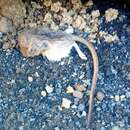en
names in breadcrumbs


Nocturnal species. Burrows usually in sand mounds not used for food storage. Feeds on various plant parts but in captivity takes apples, carrots, vegetables and mice food. Very resistant to high temperatures and lack of food and water. Tristram's jird may breed throughout the year with peak in breeding activity from April to September and female gives birth to a litter of one to seven blind and naked young after a gestation period of 25-29 days. The young are weaned after 14-15 days and male can live for 882 days while female for 643 days.
Tristram’s jird is a small jird. Fur on the upperparts varies in color from pale to dark yellowish brown, the side with narrow but conspicuous line of clear yellowish or orangish color running to the flanks, onto the outer forelegs, hind legs. Underparts and feet white. Ear sparsely covered with short white hairs and with long hairs fringing anterior margin. The distal one-third of the ear pigmented. Mystacial, pre- and suborbital areas slightly paler than the head hairs. Conspicuous and grayish postorbital spot. Conspicuous and whitish postauricular patch. Tail color on the upper surface as back and underside at base orangish. Tail brush inconspicuous, blackish, occupies about one-fourth of the tail length. Palm bare. Sole of the feet partly without hairs and with pale claws.
Localized (northeast Sinai).
Tristram's jird lives in sand or clay soils along Mediterranean coast.
Body length: 121–134 mm. Tail length: 125–140 mm.
Native, resident?
Tristram's jird (Meriones tristrami) is a species of rodent that lives in the Middle East. It is named after the Reverend Henry Baker Tristram who collected the first specimens. It is up to 155 mm (6.1 in) long, and lives in burrows in steppes and semi-deserts from Turkey and the Caucasus to Israel and Iran. Records from the Greek island of Kos represent the only gerbils reported from Europe, outside the former Soviet Union. It is a common, widespread species, and is not considered to be threatened.
Meriones tristrami reaches a total length (excluding the tail) of 100–155 millimetres (3.9–6.1 in), with a skull around 32–40 mm (1.3–1.6 in) long.[4] Its fur is "dark yellowish-brown" on its back, "yellowish orange" on its sides, and white on the belly.[5] The soles of its hind feet are hairless at the heels, and it has a much smaller auditory bulla than the other jirds that occur in the same region.[4] The tail is bi-colored, and ends in an inconspicuous black tuft, about one quarter of the length of the tail.[5]
Meriones tristrami is found from Turkey in the west, to the Caucasus (Armenia, Azerbaijan), and south through Iraq, Syria, Lebanon and Israel to Jordan and Iran. It has also been recorded from the Greek island of Kos, although it has not been seen there for more than a decade.[1] The records of M. tristrami from Kos are the only reports of a gerbil from a European country (excluding the former Soviet Union), or from an island in the eastern Mediterranean Sea.[6] Fossil evidence, however, shows that it has lived in the southern Levant for at least 160,000 years.[3]
It lives in semi-deserts and steppes, and is supposedly limited to areas receiving an annual total precipitation of at least 100 millimetres (3.9 in). It feeds on various seeds and leaves, but although it lives in burrows, it does not store any food there.[1]
Meriones tristrami was first described by Oldfield Thomas in 1892.[3] He based his description on type material from the Dead Sea region of Israel collected by "Canon H. B. Tristram" (Henry Baker Tristram), who is commemorated in the specific epithet tristrami.[2] It is classified in the subgenus Pallasiomys of the gerbil genus Meriones, and its members have sometimes been included within the species Meriones shawi.[3]
A number of subspecies have been described within M. tristrami, but the genetic differences between them are slight,[7] and no subspecies are recognised in Mammal Species of the World.[3]
Meriones tristrami has a wide geographical range, including many protected areas, and has no serious threats. It is therefore listed as being of Least Concern on the IUCN Red List.[1]
![]() Data related to Meriones tristrami at Wikispecies
Data related to Meriones tristrami at Wikispecies
Tristram's jird (Meriones tristrami) is a species of rodent that lives in the Middle East. It is named after the Reverend Henry Baker Tristram who collected the first specimens. It is up to 155 mm (6.1 in) long, and lives in burrows in steppes and semi-deserts from Turkey and the Caucasus to Israel and Iran. Records from the Greek island of Kos represent the only gerbils reported from Europe, outside the former Soviet Union. It is a common, widespread species, and is not considered to be threatened.